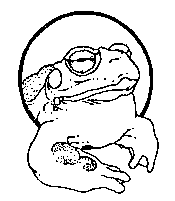 The Sonoran Desert Toad
The Sonoran Desert Toad The Sonoran Desert Toad
The Sonoran Desert Toad
Breeding Activity, Estimated Age-Structure, and Growth in Sonoran Desert
Anurans
Brian K. Sullivan and Philip J. Fernandez
Herpetologica Sept. 1999; 55 (3): 334-343.
Abstract:
We investigated breeding activity of a community of desert anurans at two sites in north-central Phoenix, Maricopa County, Arizona, during 1990-1995. Four species used these sites for breeding during the summer monsoon season: Colorado River toad, Bufo alvarius, Great Plains toad, B. cognatus, red-spotted toad, B. punctatus, and Couch's spadefoot toad, Scaphiopus couchii. Breeding activity was restricted primarily to 1990 and 1992 when significant rainfall events (>25 mm of rainfall within 24 h) occurred repeatedly. No breeding (i.e., oviposition) occurred during 1991 or 1993, and only S. couchii bred on a single night in 1994 and B. alvarius on a single night in 1995. We undertook a skeletochronologic analysis of lines of arrested growth in digits and femurs with all four study species. Conservative estimates of age based on lines of arrested growth (LAG's) suggest that populations of all four taxa were relatively young (average age between two and four years) at both
sites in 1994 and 1995. Growth, as indicated by the amount of bone deposited between LAG's, was greatest during the second year in B. alvarius and B. cognatus, but not B. punctatus or S. couchii. These results indicate rapid growth to maturity but do not support the notion that these anuran amphibians are long-lived organisms that exhibit an extended reproductive lifespan as adults in response to a highly variable, harsh desert environment.
Natural Hybridization Among Distantly Related Toads (Bufo alvarius, Bufo cognatus, Bufo woodhousii) in Central
Arizona
Erik W.A. Gergus, Keith B. Malmos, and Brian K. Sullivan
Copeia May, 1999; 199 (2): 281-286.
Abstract:
Putative hybrid toads of the genus Bufo were collected in central Arizona and identified using allozymes, qualitative and quantitative morphological characters, and release call characteristics. Data suggest one hybrid resulted from mating between Bufo cognatus and Bufo woodhousii, and the other three resulted from matings between Bufo alvarius and B. woodhousii. Natural hybridization between these taxa has not been previously reported. To date, B. woodhousii has been found to hybridize with four species of the Bufo americanus species group, of which B. woodhousii is a member, and five other species which represent three outgroups to the B. americanus group. Fossil evidence suggests some genomic compatability has been retained between B. alvarius and B. woodhousii despite at least 6 million years of independent evolution. Hybridization among members of Bufo may be due to alternative mating tactics of males, such as active searching, and by alteration of
historical habitats in central Arizona.
The Spinal Nerves Innervate Putative Chemosensory Cells in the Ventral
Skin of Desert Toads, Bufo alvarius
Hiromichi Koyama (1), Takatoshi Nagai (2), Hiro-aki Takeuchi (3), Stanley D.
Hillyard (4)
(1) College of Nursing, Yokohama City University, Yokohama 236-0004, Japan
(2) Department of Physiology, Teikyo University School of Medicine, Kaga 2-11-1,
Itabashi-ku, Tokyo 173-8605, Japan E-mail: takatosh@med.teikyo-u.ac.jp Phone:
+81-45-566 1328 Fax: +81-45-566 1328
(3) Department of Biology and Geoscience, Faculty of Science, Shizuoka
University, Shizuoka 422-8529, Japan
(4) Department of Biological Sciences, University of Nevada, Las Vegas, Nevada
89154, USA
Received: 30 August 2000 / Accepted: 30 January 2001 / Published online: 27
March 2001
Abstract:
Toads normally obtain water by absorption across their skin from
osmotically dilute sources. When hyperosmotic salt solutions are presented as a
hydration source to dehydrated desert toads, they place the ventral skin onto
the source but soon afterwards escape to avoid dehydration. The escape behavior
coincides with neural excitation of the spinal nerves that innervate putative
chemosensory cells in the ventral skin. In the present study, fluorescent dye
translocated through the spinal nerves to those receptor cells in the epidermis
was photoconverted in the presence of 3, 3'-diaminobenzidine tetrahydrochloride
for electron-microscopic observation of the cells and associated nerve
terminals. Most of the photoconverted cells were located in the deepest layer of
the epidermis, with some being in more intermediate layers. No labeled cell was
seen in the outermost layer of living cells. In desert toads, flask cells and
Merkel cells are occasionally seen in the epidermis. An association of nerve
fibers with these epidermal cells has been reported in some species of the
anurans. In the present study, however, the cytological features of the
photoconverted cells are neither reminiscent of flask cells nor Merkel cells,
but are similar to those of surrounding epithelial cells in each layer of the
epidermis. We hypothesize a sensory function for these cells, because they have
a close association with nerve fibers and participate in the transepithelial
transport of salts that must pass through all cell layers of the skin.